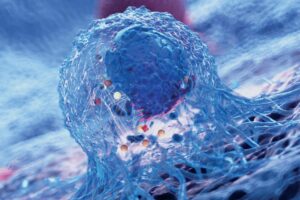What is already known
Chronic obstructive pulmonary disease (COPD) is characterized by a progressive decrease in lung function. Airway dysbiosis is observed in COPD, but it is unclear whether it plays a role in the progression of the disease.
What this research adds
A longitudinal study was conducted on COPD patients and revealed that baseline airway dysbiosis in these patients is characterized by an enrichment of opportunistic pathogen bacteria, and is linked to a rapid decline of forced expiratory volume in one second (FEV1s) over two years. Dysbiosis was also strongly correlated to exacerbation-related FEV1 fall and sudden FEV1 fall at stability, contributing to long-term FEV1 decline. Staphylococcus aureus was observed in the airway and was found to decrease lung function through homocysteine, which triggers a shift from neutrophil apoptosis to NETosis via the AKT1-S100A8/A9 axis. Depletion of S. aureus in mice with emphysema restored lung function and suggests a novel method of slowing COPD progression by targeting the airway microbiome.
Conclusions
Airway dysbiosis was associated with a lung function decline in COPD patients and it might contribute to this phenotype through metabolic interaction with host pathophysiological processes. Targeting microbe-host interaction could be a viable therapeutic option
to slow COPD progression.
Chronic obstructive pulmonary disease (COPD) is the third leading cause of mortality worldwide and it is characterized by progressive decline in lung function, commonly measured by the changes in forced expiratory volume in 1 second (FEV1). Several studies have shown the link between disruption of the airway microbiota and COPD and how this is associated with deteriorated clinical outcomes.
A recent cross-continental, multi-cohort study, led by Wang and colleagues, and published in Cell Host Microbe journal, revealed that airway dysbiosis accelerated lung function declines, a hallmark phenotype in COPD. Sputum samples from two cohorts of COPD patients were analysed in order to assess lung function.
Through a cross-continental, multi-cohort, longitudinal analysis, the authors showed that opportunistic pathogens were associated with rapid FEV1 declines in COPD. These taxa were associated with key events including exacerbation-related FEV1 fall and sudden FEV1 fall at stability. Moreover, S. aureus was found to promote lung function declines through the homocysteine-AKT1-S100A8/A9 axis.
Airway dysbiosis was associated with accelerated FEV1 decline
The decline rate of lung function was calculated for each participant and patients were classified into rapid decliners, slow decliners, and non-decliners. Differential sputum microbiota was observed at baseline among the three groups of participants, with rapid decliners and slow decliners showing a non-significantly reduced alpha diversity compared with non-decliners.
Microbiome-based classifiers showed higher predictability for rapid decliners than slow decliners and non-decliners. Bacteria including Moraxella, Actinobacillus, Stenotrophomonas, Ochrobactrum, Aggregatibacter, Gemellaceae, Abiotrophia, Achromobacter, and Staphylococcus were enriched in rapid decliners, whereas Haemophilus and Neisseria were most enriched in slow decliners and non-decliners, respectively.
Many rapid decliners-enriched genera contained opportunistic pathogens and had a relatively sparse distribution among individuals. The presence of Actinobacillus, Stenotrophomonas, Ochrobactrum, Achromobacter, or Staphylococcus at baseline was associated with greater FEV1 decline rates and the co-presence of Actinobacillus, Staphylococcus, and Stenotrophomonas had the greatest increment in FEV1 decline.
Microbiome-host interactions associated with accelerated FEV1 declines
To validate these results, the authors performed the same analysis on a third, independent COPD cohort of patients from China. The participants were similarly classified as rapid decliners, slow decliners, and non-decliners according to 1-year FEV1 decline. Likewise, microbiota differed among the three groups. Moraxella catarrhalis, Staphylococcus aureus, Gemella haemolysans, Actinobacillus sp., and Achromobacter sp. were rapid decliners-enriched, validating the findings in UK cohorts. The co-presence of M. catarrhalis and Actinobacillus sp. had the greatest increment in FEV1 decline. Neisseria subflava and Mycoplasma salivarium were non-decliners-enriched, a finding that replicated that in UK cohorts.
A number of bacteria metabolites were found enriched in the sputum of rapid decliners, slow decliners, and non-decliners, and biological links for microbiome-metabolite-host interaction were identified, leveraging microbial genetic information and established metabolite-host pairs. The FEV1 decline rate of individuals from all three groups was predicted to assess the importance of each microbiome-metabolite-host gene link to FEV1 decline. The link with the highest predictability for rapid decliners was S. aureus-homocysteine-AKT1. S. aureus-homocysteine-S100A8 was also among the top links for rapid decliners.
An overall increasing trend of IgA, IgG, and IgM was observed in the sputum of patients with the presence of rapid decliners-enriched bacteria, and an increasing trend of CD8+ T cells as well as memory B cells associated with five and four rapid decliners-enriched bacteria, respectively. These results suggest the possible involvement of host adaptive immunity in response to rapid decliners-associated airway dysbiosis.
S. aureus promoted lung function decline via homocysteine-AKT1-S100A8/A9 axis
To assess the effects of the rapid decliners-enriched bacterial taxa, the authors selected one bacterial species from each of the genera identified as rapid decliners-enriched in both UK and Chinese cohorts, and inoculated mice with a low dose of each bacterium over a 4-week period. Administration of the five species all resulted in a declined lung function, with the effects of S. aureus generally being the most pronounced. A unique elevation of homocysteine was observed for S. aureus in the mouse bronchoalveolar lavage fluid.
Homocysteine was the only metabolite significantly elevated by S. aureus inoculation in mice and enriched in rapid lung function decliners in human. Inoculation of all five bacterial species resulted in an increased proportion of B cells, CD8+ versus CD4+ T cells, as well as elevated IgA, IgG, and IgM in mouse lung tissue, suggesting potential involvement of host adaptive immunity in response to these bacteria. Together, these results support the relative importance of the pathogenicity of S. aureus and homocysteine to be focused for further studies.
To mimic key COPD pathological features, a murine model of emphysema was established. Emphysema mice were colonized with S. aureus and showed a significantly reduced lung function, increased tissue injury, and enhanced influx of neutrophils, compared with those colonized with control bacteria and non-colonizing controls. In support of the S. aureus-homocysteine link, the airway homocysteine was increased in emphysema and control mice with S. aureus inoculation. In particular, the emphysema mice receiving S. aureus experienced a faster lung function decline compared with controls, recapitulating the phenotype in human COPD.
To assess whether S. aureus contributed to lung function declines through homocysteine, the emphysema mice were inoculated with mutant S. aureus, a mutant form without the gene for the homocysteine synthesis. This resulted in reduced airway homocysteine, attenuated lung function decline, less tissue injury and neutrophil influx, as well as a slower lung function decline over the next 4 weeks, indicating that homocysteine is responsible for the pathological phenotype.
Moreover, administration of homocysteine led to declined lung function, elevated tissue injury, emphysema, neutrophil influx, and collagen deposition as well as a significant upregulation of the genes in neutrophilic degranulation including S100A8 in the emphysema mice. Furthermore, an increased AKT1 phosphorylation was observed in the lung tissues and lung neutrophils of emphysema mice in response to homocysteine, supporting the homocysteine-AKT1 link. Homocysteine administration led to increased neutrophil extracellular traps (NETs) production, which was abrogated when the AKT1 inhibitor was co-administered. These results suggest that homocysteine activates host AKT1 to switch neutrophil death from apoptosis to NETosis toward enhanced inflammation, tissue injury, and lung function declines, via AKT1. Furthermore, the inhibition of S100A8/A9 abrogated the pathogenetic effects of homocysteine in emphysema mice. Together, these data suggest that chronic airway S. aureus colonization promotes lung function declines in emphysema through the production of homocysteine, which leads to persistent neutrophilic inflammation via the AKT1-S100A8/A9 axis.
S. aureus bacteriophage alleviated lung function declines in emphysema mice
The authors finally explored possible therapeutic solutions. Thus, they isolated the bacteriophage S. aureus phage LJT-1, capable of lysing S. aureus ATCC 6538 without targeting other major members of the airway microbiota.
The chronic airway colonization of S. aureus ATCC 6538 was repeated over the first 4 weeks and mice were intranasally inoculated with the phage either in a prophylactically way, during disease establishment; or therapeutically, post-disease establishment. For emphysema mice colonized with S. aureus, prophylactic phage treatment led to reduced lung function declines, tissue injuries, and neutrophil influx, as well as decreased airway homocysteine. A marked depletion of S. aureus was observed in S. aureus-colonizing mice lungs after phage treatment, without a significant perturbation of the overall microbiota. The lung function was non-significantly altered by phage therapy in emphysema mice without initial S. aureus colonization.
Therapeutic phage treatment in S. aureus colonizing mice post-disease establishment led to a slower decline of lung function along with rapid S. aureus depletion. Safety assessment indicated no notable phage-induced organ injuries. These results suggest that S. aureus phage could be a potential therapeutic agent to overcome COPD lung function declines.
Overall, findings from the study confirm current evidence associating microbial genera containing airway-opportunistic pathogens with worse clinical outcomes in chronic and acute lung diseases. Monitoring the airway microbiota may help identify patients with a risk of rapid lung function decline for more aggressive management, and targeting microbe-host interaction could be a viable therapeutic option to slow COPD progression.











